Declutter Before Moving to Save Money and Stress
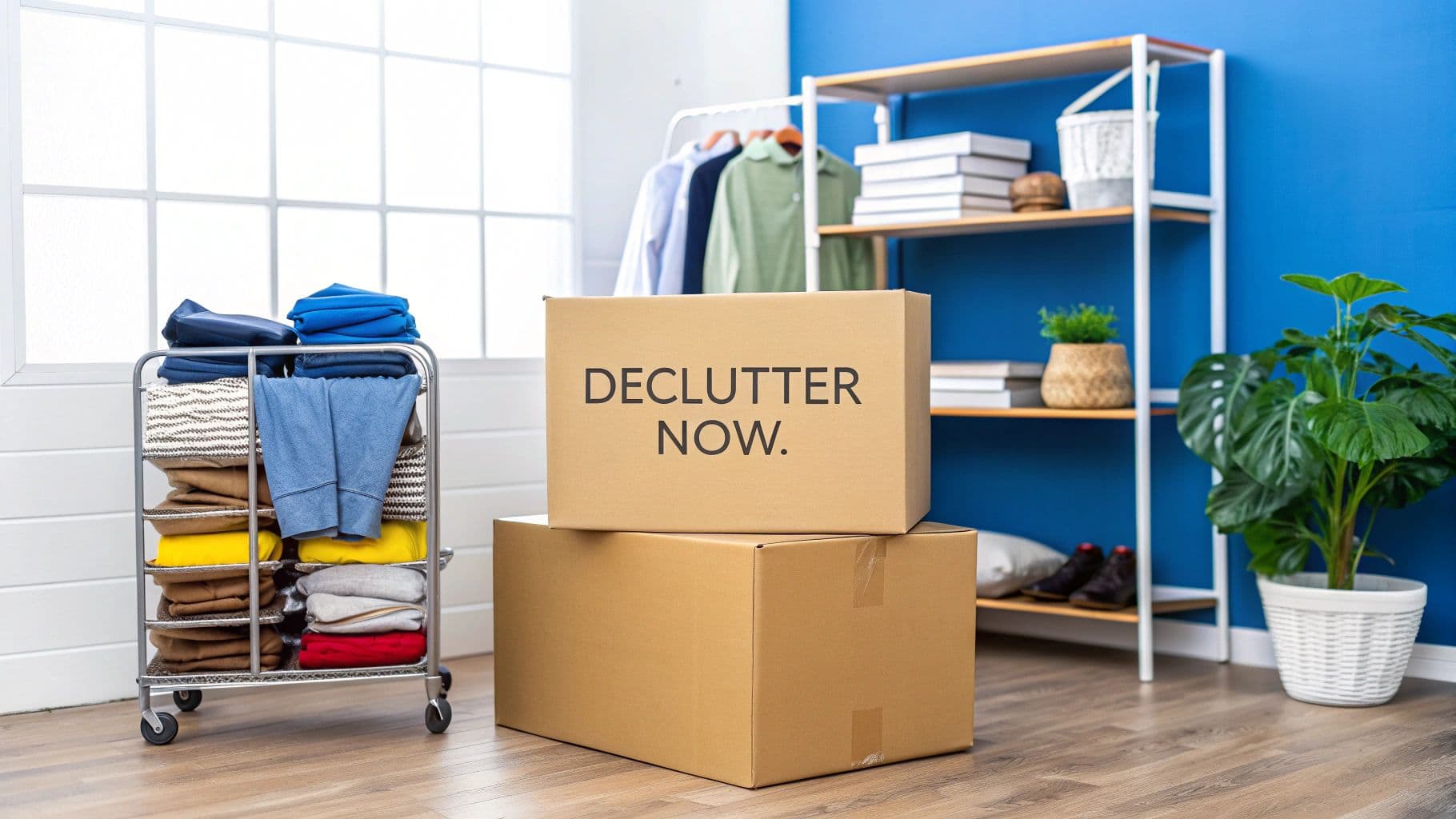
Let’s be honest: moving is a massive undertaking. But there’s one secret weapon that can make the entire process cheaper, faster, and far less stressful. It’s not a fancy moving service or a new packing technique. It’s simply getting rid of things before you even think about putting them in a box.
Treating decluttering as the first, most crucial step isn't just another chore to add to your list. It's a strategic move that pays off in both time and money, setting you up for a truly fresh start in your new home.
Why You Absolutely Must Declutter Before Moving
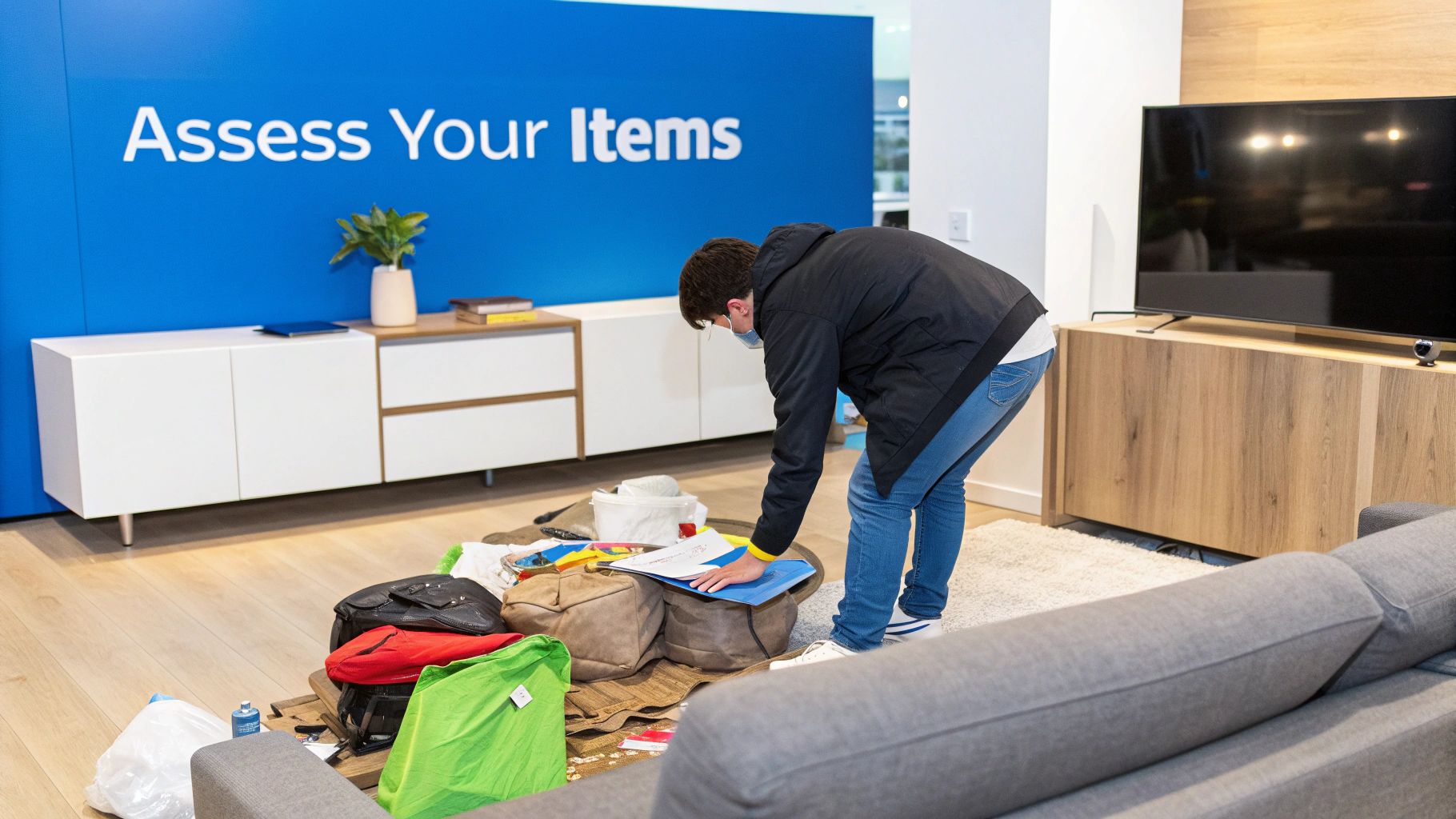
Think about it—every single object you own has to be touched, sorted, packed, lifted, moved, and then unpacked. The more stuff you have, the bigger the job becomes. It’s a simple equation. By cutting down on the volume of your possessions, you simplify every single stage of the relocation.
The financial upside is impossible to ignore. Professional movers charge based on the weight and volume of your shipment. Every single pound matters. That unused exercise bike in the garage or the box of old college textbooks in the attic? They aren't just collecting dust; they are actively adding dollars to your moving quote.
The Direct Impact on Your Wallet
It’s easy to see how the costs add up. Imagine a family moving from a three-bedroom house into a smaller two-bedroom apartment. They've got a garage full of forgotten tools, closets stuffed with clothes that haven't fit in years, and an attic filled with holiday decor they never use.
If they decide to move all of it, they’re paying for:
- More supplies: Extra boxes, endless rolls of tape, and piles of bubble wrap.
- Higher moving fees: The total weight and cubic footage of their shipment will be significantly higher.
- A bigger truck: This alone can push their quote into a completely different, more expensive price tier.
By being ruthless and purging those items beforehand, the family could easily shed hundreds of pounds from their shipment. That translates directly into real, substantial savings.
The numbers don't lie. Reducing the sheer volume of what you're moving is the most effective way to lower your costs. Here’s a quick look at how purging common household items can directly impact your final bill.
How Decluttering Impacts Your Moving Costs
| Item Category | Typical Volume (Cubic Feet) | Estimated Weight (lbs) | Potential Cost Saving (per 100 miles) |
|---|---|---|---|
| Old Queen Mattress | 40 cu ft | 70 lbs | $35 - $50 |
| Unused Bookshelf | 20 cu ft | 50 lbs | $25 - $40 |
| Box of Old Clothes | 5 cu ft | 35 lbs | $15 - $25 |
| Forgotten Exercise Bike | 25 cu ft | 100 lbs | $50 - $70 |
As you can see, the savings from just a few items add up quickly, especially on a long-distance move. Every item you sell, donate, or discard is money back in your pocket.
Moving is a huge event. In 2021 alone, an estimated 22 million people relocated within the U.S. Because expenses are so closely tied to the weight of your possessions, lightening the load is your best bet for saving money. You can find more great insights on moving and decluttering in AARP's detailed guide.
The Psychological Freedom of a Fresh Start
Beyond the very real financial benefits, there's a powerful psychological reward. Nothing is more deflating than arriving at your new home, exhausted from the move, only to be surrounded by boxes filled with stuff you don't even like or need. You haven't solved your clutter problem; you've just given it a new address.
Now, picture the alternative. You walk into your new space, and every box you open contains items that are useful, meaningful, or beautiful. You are intentionally building your new life from the ground up. This process is your chance to leave behind not just physical objects, but the stagnant energy tied to them. It’s an incredible opportunity to redefine your space, unburdened by the past.
A Room-By-Room Decluttering Game Plan
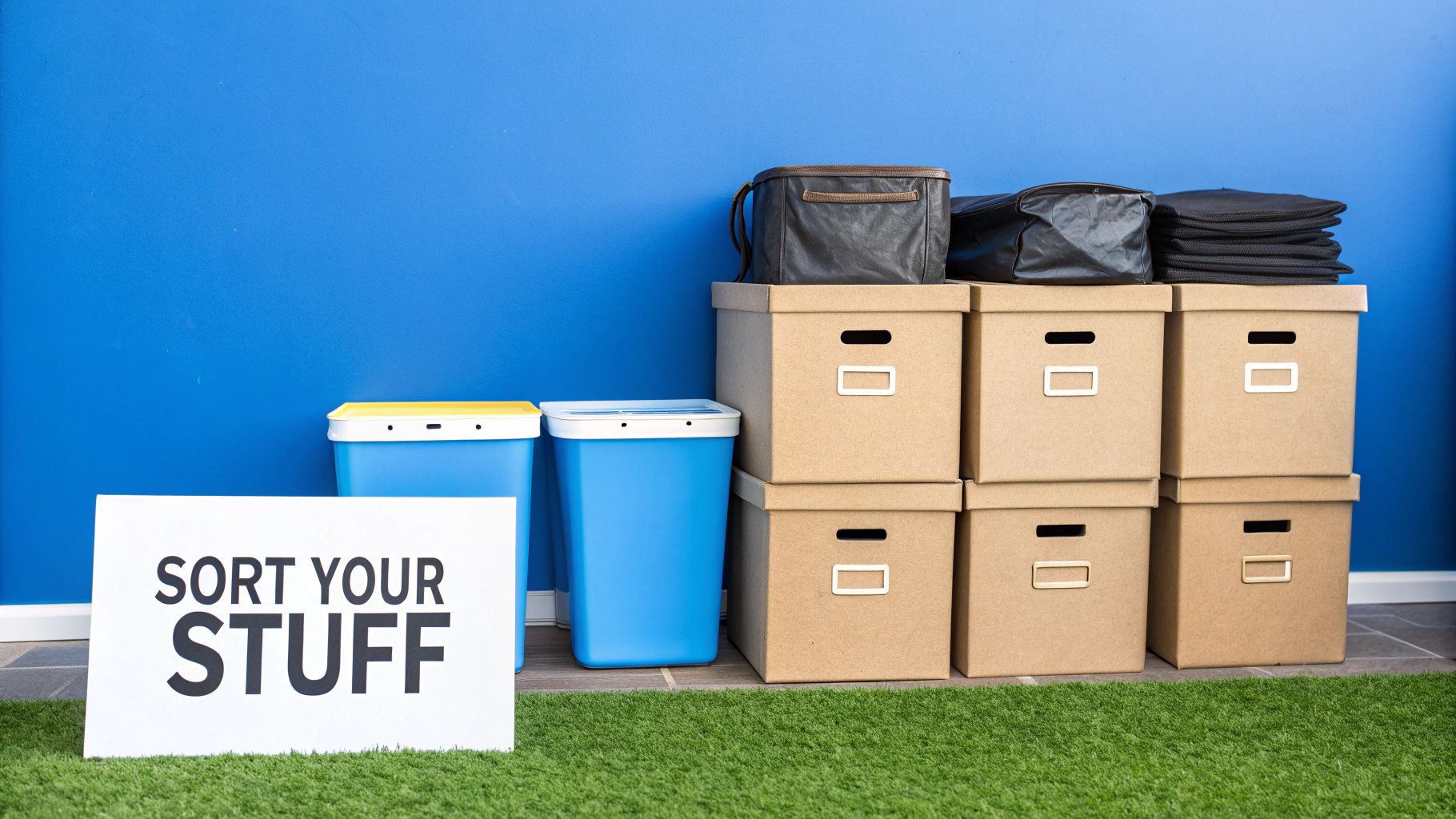
Trying to declutter an entire house at once is a surefire recipe for burnout. I've seen it happen countless times. A much smarter strategy is to break the enormous task into smaller, more manageable zones.
This room-by-room approach helps you build momentum. Instead of staring at the whole mountain, you're just focused on one small hill at a time. It also gives you that crucial feeling of visible progress, which is everything when you're trying to stay motivated. A good rule of thumb is to start with the rooms you use less often, like guest rooms or storage areas, and work your way toward high-traffic hubs like the kitchen. This way, you aren't packing away essential items too early.
Start With Bedrooms and Closets
Bedrooms and closets are often ground zero for clutter that’s surprisingly easy to part with. This makes them the perfect place to build your decluttering confidence before tackling the rest of the house.
Your closet is the best place to begin. Be brutally honest and apply the one-year rule: if you haven't worn something in the last 12 months, it’s a prime candidate for donation or sale. Think about your new home's climate and your future lifestyle. Are five heavy winter coats really necessary for a move to Florida?
- Clothes: Go through everything. Get rid of items that don't fit, are hopelessly out of style, or are damaged beyond repair.
- Shoes & Accessories: How many pairs of black flats do you truly need? Consolidate your collection and keep only your absolute favorites.
- Nightstands & Dressers: These spots are magnets for random odds and ends. Clear them out completely, sorting everything into simple keep, donate, or trash piles.
Tackle the Kitchen and Pantry
The kitchen is the heart of the home, which also means it’s a hotspot for duplicate gadgets, impulse-buy appliances, and expired goods. A systematic clear-out here can significantly lighten your moving load and reduce stress.
Start with the pantry. Toss any expired food, spices you never actually use, and that half-empty bag of specialty flour from the one time you tried making sourdough. This alone can free up a shocking amount of space.
Next, move on to your gadgets and utensils.
Do you really need the quesadilla maker, the mini donut machine, and the bread maker you used once back in 2019? If an appliance hasn't seen the light of day in over a year, it's time to let it go. Remember, movers often charge by weight, and these bulky items add up fast.
Finally, take a hard look at your dishes and cookware. Decide on your core set of essentials and pack them last. Now is the time to say goodbye to chipped plates, mismatched mugs, and the three extra spatulas you somehow acquired over the years.
Purge Living Areas and Storage Zones
Living rooms and home offices can be tricky because they contain a mix of sentimental, functional, and purely decorative items. The key here is to focus on what will genuinely fit the layout and feel of your new space.
For things like books, movies, and decor, ask yourself if they still bring you joy or serve a real purpose. Could you switch to digital versions of your favorite films or get excited about exploring the library in your new town?
The garage, attic, and basement are often the final frontiers of clutter. These spaces can feel overwhelming, so it’s essential to go in with a plan. For larger collections of tools, old furniture, or inherited belongings that you won't be taking, a structured approach is critical. You can find excellent guidance in a comprehensive estate cleanout checklist to help manage this part of the process efficiently. By methodically sorting these large areas, you can uncover valuable items to sell while finally discarding things that are just taking up space.
The Four-Box Method for Decisive Sorting
Let’s be honest: decision fatigue is the number one enemy when you’re trying to declutter before a move. Standing in a room, staring at a mountain of your own stuff, and trying to decide the fate of every single object is completely paralyzing.
To cut through that mental fog, you need a system. The Four-Box Method is brilliantly simple and forces you to make quick, definitive choices.
Instead of creating messy, undefined piles, you’ll set up four distinct stations. Grab some boxes, laundry baskets, or just tape off four corners of the room. Label them clearly: Keep, Sell/Donate, Discard, and Relocate. This small bit of prep work creates a framework that eliminates waffling.
Defining Your Sorting Categories
Here’s the golden rule: every single item you touch must immediately go into one of these four categories. No "maybe" pile. The goal is a swift, gut-level choice so you can move on to the next thing.
-
Keep: This box is only for items you actively use, genuinely love, or know for a fact have a designated spot in your new home. Be brutally honest. Are you really going to use that bulky bread maker you got three years ago, or are you just attached to the idea of it? Only keep what adds value to your life right now.
-
Sell/Donate: This is for all the good-condition items that no longer serve a purpose for you. Think clothes you haven't touched in over a year, duplicate kitchen gadgets, or that armchair that simply won't fit the new floor plan. A quick gut check on an item's condition and potential value helps you decide whether to sell it or just donate it.
-
Discard: This one is easy. It’s for anything broken beyond repair, expired, or just plain worn out. Don't waste your time, energy, or moving budget on things that belong in the trash or recycling bin.
-
Relocate: This box is a true game-changer. It’s for things that are in the right home but the wrong room. You know, the book that migrated from the office to the bedroom, or the scissors that belong in the kitchen junk drawer. At the end of a sorting session, you can do one quick lap and put all these items back where they belong.
This methodical approach turns a chaotic mess into an organized process. By killing indecision, you sidestep the emotional drain that makes decluttering so exhausting. The entire experience becomes faster and way more productive.
The visual guide below shows you exactly how to think about each item as you pick it up.
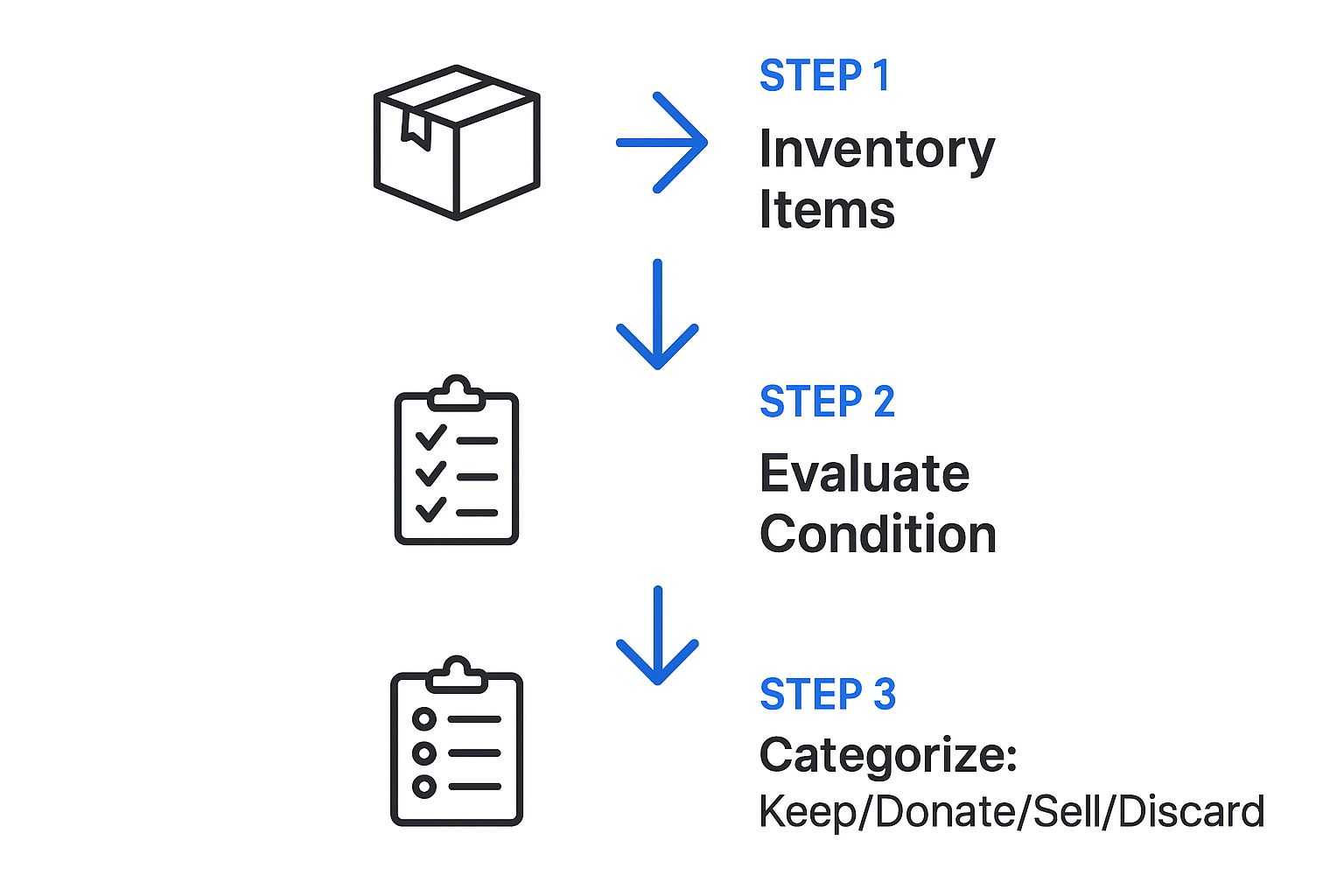
Following this process forces you to evaluate each item's true condition and worth before deciding its fate, making sure you only pack things that actually matter.
Special Strategies for Long-Distance Moves
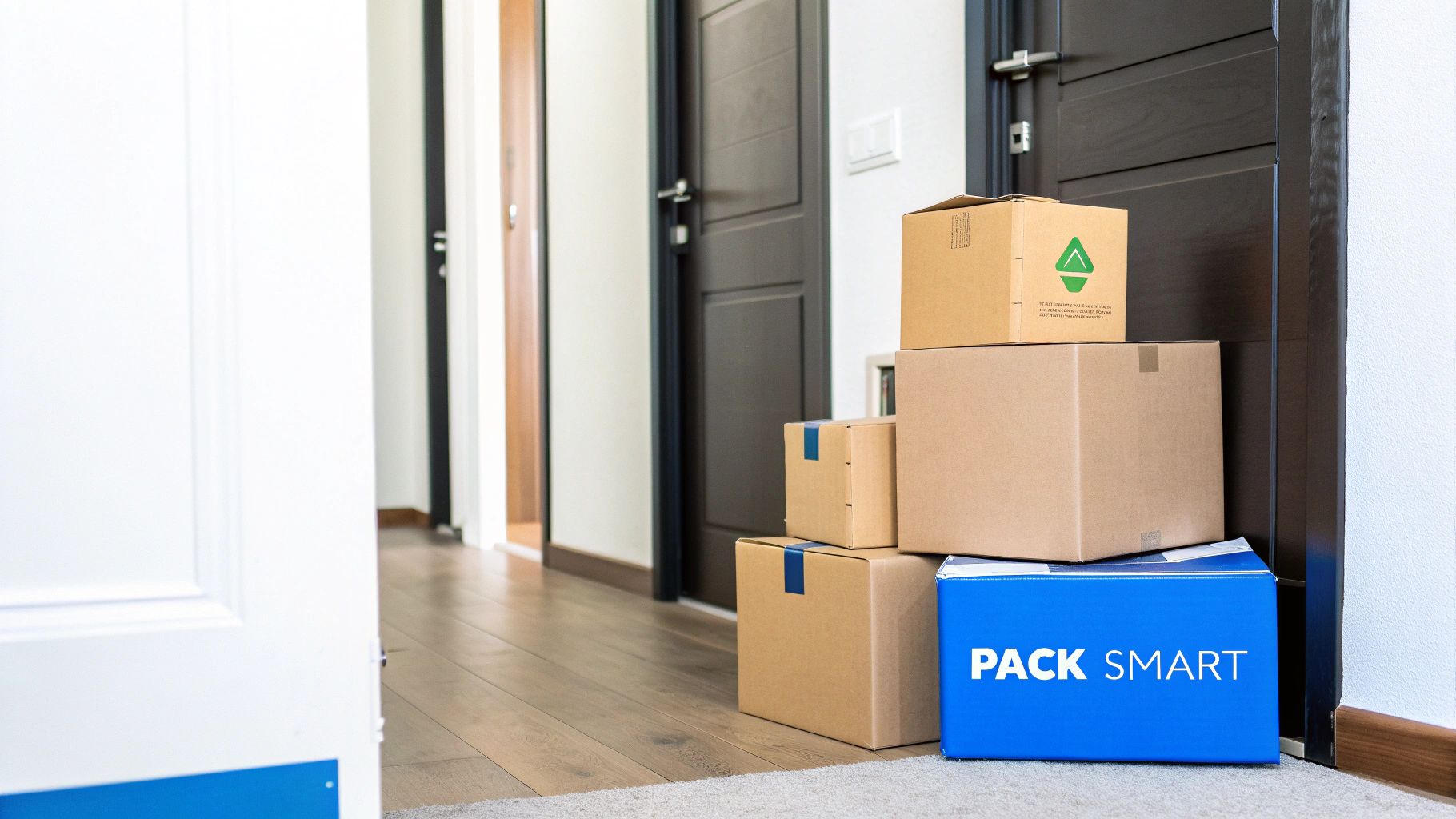
Moving across town is one thing. Moving across the country—or even internationally—is a completely different beast. Suddenly, decluttering goes from a smart idea to an absolute financial necessity.
Why? Because the costs and logistics multiply with every mile. While a local moving company might charge by the hour, long-distance movers almost always bill you based on the weight and volume of your shipment. This is where getting ruthless with your belongings becomes your most powerful money-saving tool.
Every extra box, every piece of furniture you're on the fence about, adds directly to your final invoice. For international moves, it gets even more complicated with container shipping fees, customs duties, and taxes that can turn your possessions into a massive liability. That old sofa isn't just taking up space anymore; it could easily cost you more to ship than it’s even worth.
This reality forces a major shift in thinking. When you’re staring down thousands of dollars in shipping costs, you start to see your stuff in a whole new light.
Calculating the True Cost of Your Stuff
Let's look at a real-world scenario. A family is planning a move from the United States to a major European city. They have a house full of furniture—a sectional, a king-sized bed, a dining set, the works. After getting a few quotes, they're floored. The cost to ship everything in a container is over $10,000.
That’s a game-changer. They quickly pivot, deciding to sell all the bulky furniture and use that cash to buy new (or gently used) items once they arrive. This single decision saves them thousands in shipping fees and avoids a world of headaches with customs, potential damage, and delivery logistics overseas.
The financial logic is simple: every item has a transportation price tag. For many people, this is a surprisingly liberating realization. For example, a couple moving to London found it was far cheaper to minimize what they took and replace items abroad rather than pay a fortune to ship everything. You can read more about how downsizing simplifies international moves in this ultimate guide from The Portable Wife.
Beyond Furniture: Practical Considerations
The need to declutter for an international move goes way beyond just the big stuff. You have to think about the practical differences that could make your belongings completely useless in your new country.
-
Electrical Appliances: Different countries, different plugs, different voltages. Europe and much of the world run on 220-240V, while North America uses 110-120V. Your beloved coffee maker, hair dryer, and kitchen gadgets might not work at all, or they’ll require bulky, expensive converters. In almost every case, it's cheaper and safer to just sell them and buy local versions when you get there.
-
Space and Lifestyle: That oversized, comfy American-style furniture might not even fit through the door of a historic European apartment. Be realistic about the size and layout of your new home. Researching your new city’s typical living spaces can save you a world of trouble.
When moving long-distance, your goal should be to only transport items that are irreplaceable, have extreme sentimental value, or are prohibitively expensive to replace. Everything else is a candidate for selling or donating.
This ruthless prioritization isn't just about saving money; it’s about simplifying a profoundly complex process. Arriving in a new country with only your most essential and cherished belongings makes settling in faster, easier, and far less stressful. You're not just moving your home; you're curating the start of your new life.
How to Turn Your Clutter Into Cash
So you've sorted through everything, and now you have a promising 'Sell' pile staring back at you. This isn't just clutter; it's an opportunity. Turning these items into cash is a fantastic way to help cover moving expenses or just pad your bank account.
Honestly, it transforms one of the most dreaded parts of moving into something that’s actually pretty rewarding.
The trick is to focus on items with real resale potential. I'm talking about quality furniture that's still in great shape, electronics that haven't hit antique status yet, and unique collectibles. These are the things people are actively searching for online.
Picking the Right Place to Sell
Let’s be real: not all selling platforms are the same. Where you sell your old armchair isn't necessarily the best spot for your rare comic book collection. Matching your stuff to the right marketplace is the secret to a fast, profitable sale.
Here’s a quick rundown of my go-to options:
- Facebook Marketplace: This is your best bet for big, bulky stuff like furniture, exercise equipment, or home decor. It's totally free to list, and because it’s all local, you get to dodge the nightmare of shipping.
- eBay: The undisputed king for niche collectibles, vintage clothes, or specific electronic parts. You can reach a global audience, which often means higher prices, but just remember to account for shipping costs and platform fees.
- DIYAuctions: This is the perfect solution when you have a lot of items, like when you’re clearing out an entire house. It puts the power in your hands to run your own online estate sale, letting you sell everything in one clean event and keep the lion's share of the profit.
This approach has become so effective that even professional relocation companies are jumping on board. Some now offer "Discard and Donate" programs to help their clients sell off items, which reduces the move's weight and carbon footprint. You can actually read more about these moving industry trends and see how it’s a win-win for everyone involved.
Creating Listings That Actually Sell
A great listing is the difference between a quick sale and an item that collects digital dust for weeks. You don’t need to be a marketing genius, but a little bit of effort here goes a very long way.
First and foremost, photos are everything. Use your phone to take clear, bright pictures from several different angles. Find a spot with good natural light and a simple background. And be honest—show any scratches or dings. People appreciate the transparency.
Next up is your description. Don't just write "Used Dresser." Get specific! Try something like, "Mid-Century Modern Walnut 6-Drawer Dresser." Make sure to include the dimensions, brand name if you know it, and a quick note on the condition. The more info you give upfront, the fewer questions you'll have to field later.
Pro Tip: Bundle smaller, similar items together. Think a set of power tools, a collection of kitchen gadgets, or a box of classic vinyl records. It helps you move more inventory and feels like a great deal for the buyer.
Pricing can feel tricky, but it doesn't have to be. Just do a quick search on whatever platform you're using to see what similar items have sold for recently. If you’re feeling lost trying to value a whole house full of different things, our complete estate sale pricing guide has a ton of helpful advice. Pricing things competitively is how you get them sold fast.
Finally, always be smart about safety when meeting buyers. If it’s a small item, meet in a busy, public place. For large items that need to be picked up from your home, make sure a friend or family member is there with you.
Common Decluttering Questions Answered
Even with a great plan, it’s completely normal to hit a wall or feel unsure about what to do next. You’re not alone. Here are some straightforward answers to the questions we hear all the time from people who are decluttering before a big move.
When Should I Start This Process?
You’ll want to give yourself a solid 6 to 8 weeks before your moving date to begin decluttering. Honestly, this is the sweet spot. It gives you enough breathing room to sort, sell, and donate things without that frantic, last-minute pressure.
Now, if you’ve been in your home for decades or you just know there’s a mountain of stuff to go through, starting even earlier is a brilliant move. Think about blocking out time around 3 months before the move. This approach lets you tackle the project in manageable chunks and helps you avoid that classic decluttering burnout.
How Do I Handle Sentimental Items?
This is, hands down, the toughest part for almost everyone. The real trick is to understand that the memory isn't in the object itself. You can let go of the item without letting go of the memory.
A strategy that works wonders is creating a digital memory box. Take some really nice photos of these special pieces and jot down a sentence or two about why they matter. It’s a beautiful way to honor their meaning without paying to move and store them.
For heirlooms, think about who in your family might love and appreciate them as much as you do. When it comes to things like your kids' artwork, pick one or two absolute favorites to frame and take pictures of the rest. You get to keep the feeling without keeping the pile.
What If I Have Too Much Stuff to Sell Individually?
It's incredibly common to feel swamped by the size of your "sell" pile. This happens all the time, especially when you're clearing out a home you've been in for years or downsizing from a large space. Trying to sell dozens of items one by one on different apps can quickly turn into a stressful, full-time job.
This is exactly when a consolidated sale becomes your best friend. For these bigger clear-outs, you can actually how to run an estate sale yourself. It’s a far more efficient way to sell a large volume of items—everything from furniture and tools to collectibles and kitchenware—in one single, organized event, saving you from the headache of managing countless individual listings.
I Am So Overwhelmed Where Do I Even Begin?
When the whole project feels impossibly huge, the secret is to start impossibly small. Seriously. Forget trying to conquer an entire room.
Pick one tiny, contained space. A single junk drawer. One shelf on a bookcase. The medicine cabinet.
Then, set a timer for just 15 minutes and focus only on that one spot. Finishing a small, defined task gives you a quick win and a little dopamine boost. That momentum is exactly what you need to break through the paralysis and get the ball rolling.